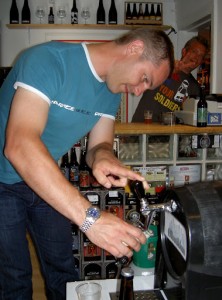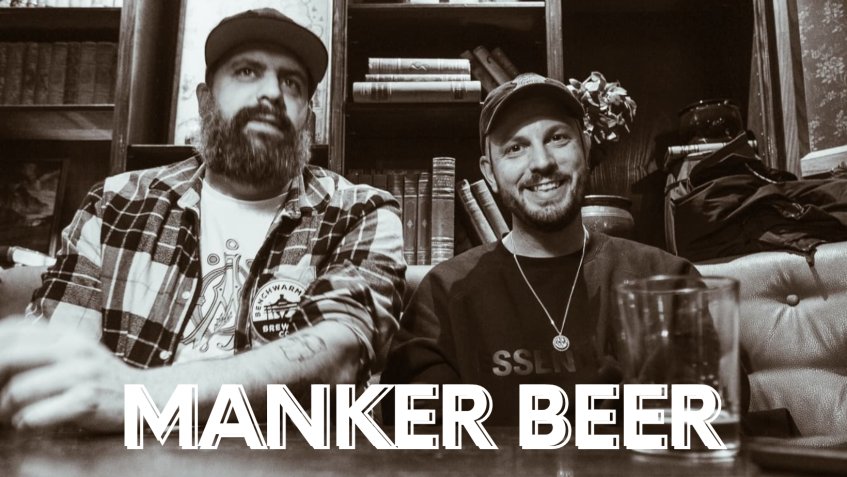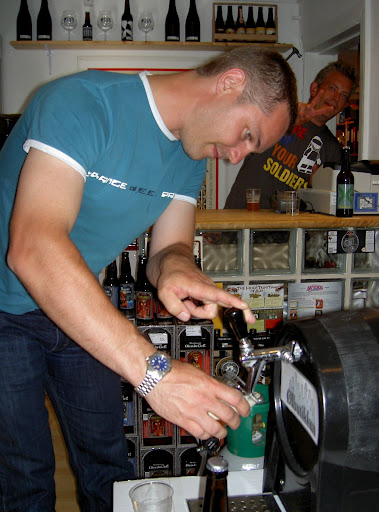MankerBeer storsatsar inför årets Stockholm Beer and Whisky Festival. Inte bara kommer vi försöka att finna nya sätt att rapportera från själva mässan utan vi kommer också att satsa på mer “inför”-material. En del i detta kommer att vara intervjuer med olika bryggare och utställare på mässan så att ni får en chans att lära känna dem lite bättre. Vi tycker att det är minst lika roligt, och viktigt, att känna till personerna bakom ölen som att prova dem. Om inte annat så kan det ge svar på varför vissa öl smaker som de gör, varifrån inspirationen kommer och vad som är på gång eller har skett.
 Tillsammans utgör de två forna flerfaldigt belönade hembryggarna Anders Østergaard och Thomas Hoelgaard Xbeeriment. Ett av vårt sydvästra grannlands mest spännande bryggerier. Med öl som den något Sverigebekanta Black Force One och Barack samt öl med namn som Sour Master Kris, Den Sure Kanon och Scarlet and Brett så gör de lite annan typ av öl än vad man kan förvänta sig. Tittar man efter på de öl de har släppt sedan de drog igång så är det desto fler suröl, lambics och allehanda mer “vågade” öl än american pale ales och IPAs. Tidigare var det skånska TWC som förestod Xbeeriment i Sverige men sedan TWC och Elixir Wines har börjat samarbeta så är det numera Elixir Wines som vi ska förlita oss på för att få prova mer av Xbeeriments öl. Vi tog ett snack med Thomas Hoelgaard om bryggeriet, succeen från Copenhagen Beer Celebration och möjligheten för oss svenskar att få prova på lite av deras hyllade lambic.
Tillsammans utgör de två forna flerfaldigt belönade hembryggarna Anders Østergaard och Thomas Hoelgaard Xbeeriment. Ett av vårt sydvästra grannlands mest spännande bryggerier. Med öl som den något Sverigebekanta Black Force One och Barack samt öl med namn som Sour Master Kris, Den Sure Kanon och Scarlet and Brett så gör de lite annan typ av öl än vad man kan förvänta sig. Tittar man efter på de öl de har släppt sedan de drog igång så är det desto fler suröl, lambics och allehanda mer “vågade” öl än american pale ales och IPAs. Tidigare var det skånska TWC som förestod Xbeeriment i Sverige men sedan TWC och Elixir Wines har börjat samarbeta så är det numera Elixir Wines som vi ska förlita oss på för att få prova mer av Xbeeriments öl. Vi tog ett snack med Thomas Hoelgaard om bryggeriet, succeen från Copenhagen Beer Celebration och möjligheten för oss svenskar att få prova på lite av deras hyllade lambic.
MB: Many Swedes will try your beers for the first time at the festival as. In short, what is Xbeeriment and what kind of beers are you focusing on?
TH: Xbeeriment is a phantom brewery. Both of us had been homebrewers for some years before we decided to go semi-pro and open Xbeeriment in 2008. We had been part of the Danish homebrewing circuit that grew rapidly in the first decade of this century. A lot of the guys that we knew here started their own microbreweries, these were guys like Christian Skovdahl (Ølfabrikken, Beer Here) and Mikkel Borg Bjergsøe (Mikkeller). What Mikkel did with Mikkeller was an inspiration to us – in the first many years he ran his brewery as a part time occupation besides his regular job as a school teacher. That was what we wanted to do as well – to open a brewery where we weren’t financially dependent upon selling large quantities of beer rapidly but instead being able to just focus on brewing the beers that we wanted to drink ourselves.
In the beginning we wanted to make extreme beers with a high level of experimentation but these days our focus has changed a bit. We still like to experiment but our main focus when making beers today is to make beers with intensive flavours but also great balance. Even though most of our beers are quite strong in regards of alcohol, we have immense focus on the issue of drinkability. Xbeeriment beers will never be cheap beers, so we feel we have an obligation to make sure that one can actually drink a whole bottle of any of our beers. So we guess the answer is not so much what kind of beers in terms of beer styles we focus on, it’s more a question of a house style in all our beers.
MB: You attended Copenhagen Beer Celebration back in May and quickly sold out on several of your beers and a great amount of the visitors held your sours beers among the best beers of the festival – what was your experience of CBC?
TH: The CBC was an absolutely amazing experience! For us as brewers we were honoured to be asked to participate and also a bit scared, really.
Before the festival we thought that with well-known breweries like 3 Floyds, Cigar City, Hoppin’ Frog, De Molen, De Struisse, Mikkeller, Evil Twin …… on the ticket, we should probably be happy if we poured half a keg of each of our beers during the 2 days.
But when the CBC opened we were surprised to see that the people coming to the festival didn’t just go for the big names, but instead were eager to simply try beers that they hadn’t seen before. And also that the word travelled fast if there was something of particular interest somewhere at the festival. And suddenly we realised that the rumour of our sours was one of the tips going round.
And we did notice a lot of Swedes amongst the very international crowd at the CBC.
Therefore we are proud to be able to offer the very last reserves of our lambic at Stockholm Beer and Whisky Festival 2012.
MB: Compared to many European colleagues the Danish breweries seems to be experiementing a lot more with what they are brewing. Why could that be?
TH: It probably has to do with the fact that few other European countries have had the lack of variety in beer as Denmark had from the end of World War II and until about 12-15 years ago. Until the late nineties you could seriously not find any other types of beer than cheaply made lagers in different alcoholic strenght and a few baltic porters on the Danish shelves. Most danes had never tried a top-fermented beer! So when the interest in craft beer took off in Denmark we weren’t bound by a lot of traditional ways to make craft beer, and a lot of the pioners of Danish craft beer like Brøckhouse, Nørrebro Bryghus and later on Mikkeller and Ølfabrikken had turned their eyes towards the US for inspiration. That is probably why the European country, whose craft beer scene has the most resemblance to the American scene, is Denmark.
That being said, most Danish micro breweries still make beers that are not at all experimenting, but just rather bland imitations of classic European styles.
But yeah, there is also a very creative, very experimenting small group of Danish micros. These are the ones beer geeks outside of Denmark have heard of, and most of these – ourselves included – actually sell most of their beer outside Denmark. Funny thing is, though, that most of these are phantom breweries. Only very few of the breweries with an actual physical brewery has taken the experimental road.
MB: From the beers that you will bring to the festival, which one would you recomend the less experienced beer drinker as well as the more experienced one?
TH: For the less experienced beer drinker, we’d recommend starting out with our “basic” IPA, Xbeeriment Madraz. This is our take on an IPA that carries inspiration from US IPA’s in terms of a massive dose of aromatic hops and a firm bitterness at the back, but also pays homage to British ales in being brewed with the biscuity Marris Otter malt and a bit of Crystal malt instead of the pilsner/munich malt favoured by a lot of US brewers. An intense beer, but not an extreme beer.
For the more experienced drinker we’d recommend our imperial stout, Xbeeriment Black Force One, which is obviously a beer with broad shoulders in terms of great body and massive flavours, but also an imperial stout that is easier to drink than many, because it doesn’t carry the very heavy residual sweetness that a lot of impys do. A very complex beer with a several layers of flavours.
And for the very experienced beer drinker, we’d recommend trying our lambic A Beer Called Horse. There are far to few brewers out there who try experimenting with making lambic style beers. Very few other beer styles have been limited to only being brewed in one quite small region. This is meant as a homage to one of the beer styles that we like the most.
MB: You recently started to cooperate with Elixir Wines and maybe we soon will see more Xbeeriment beers in Sweden, would it change the brewery or beers in any way if you suceeded to push into a new market such as the Swedish one?
TH: Well, hopefully we’ll be able to make more beers! The more clients one has, the easier it is to sell the beers, and thus it is easier to introduce new beers with smaller intervals. In that respect, as in others, size does matter.
And as mentioned above, we noticed at the CBC that a lot of the Sweedish beer geeks liked our sour beers. So if we are actually succesful in gaining ground on the Swedish beer market, we would probably consider making sours on a larger scale than the purely experimental batches we’ve done so far.
MB: And so the last one, what do you look forward to the most with SBWF?
TH: We look forward to meeting Swedish beer geeks and also the not-so-geeky who are just out for a good time and gather inspiration for what beer to drink the next time they’re going out.
And of course, as always at a beer fest, we look forward to meeting old friends and colleagues in the business as well as a bunch of new ones, hopefully.
We thank Thomas for his time and the interesting answers to our questions. I really look forward to meet Xbeeriment at SBWF and you should really follow his avice and try the beers he suggested. Start with the easier ones and move on to the more challenging ones, which are equally well tasting.
Tidigare inlägg i Manker Beer Meets – Inför SBWF 2012:
Manker Beer Meets – Inför SBWF 2012 – Marianne Wallberg / Mässgeneral
Manker Beer Meets – Inför SBWF 2012 – Shane Welch / Sixpoint Craft Ales


